


Explosive properties of chlorine dioxide
It is well-known that chlorine dioxide is an explosive compound. Working with this compound can be very dangerous. In this experiment, small quantities of this gas are made to explode. The gas simply can be ignited and then it explodes or 'burns' if the concentration is low. At sufficiently high concentrations, one even can see a flame, when the gas explodes.
 The
quantities used in this experiment are small and working with such small
quantities is fairly safe. Do not scale up this experiment. Sometimes the
gas ignites spontaneously, apparently without reason. This happened one time
while preparing some of the gas for making this webpage. Chlorine dioxide also
reacts with organic compounds, like acetone, cork and rubber. So, when this gas
is made, only use glass and do not close test tubes with rubber stoppers, use
glass wool instead.
The
quantities used in this experiment are small and working with such small
quantities is fairly safe. Do not scale up this experiment. Sometimes the
gas ignites spontaneously, apparently without reason. This happened one time
while preparing some of the gas for making this webpage. Chlorine dioxide also
reacts with organic compounds, like acetone, cork and rubber. So, when this gas
is made, only use glass and do not close test tubes with rubber stoppers, use
glass wool instead.
![]()
![]() Required
chemicals:
Required
chemicals:
-
sodium chlorite
-
concentrated hydrochloric acid, approximately 30% by weight
![]() Required
equipment:
Required
equipment:
-
test tubes
-
long glass tube
-
glass wool
![]() Safety:
Safety:
-
sodium chlorite is toxic and a strong oxidizer;
-
concentrated hydrochloric acid is corrosive;
-
chlorine dioxide is quite noxious and this experiment must be done outside or in a very well ventilated area;
-

 chlorine dioxide
is a very unstable compound when pure or when at high pressure. Do not
attempt to collect large amounts of this gas in a confined space. The gas is
notoriously explosive and can explode, apparently without any reason.
chlorine dioxide
is a very unstable compound when pure or when at high pressure. Do not
attempt to collect large amounts of this gas in a confined space. The gas is
notoriously explosive and can explode, apparently without any reason.
![]() Disposal:
Disposal:
- The waste can be flushed down the drain with a lot of water
![]()
Preparing pure chlorine dioxide from solid sodium chlorite
Put a small spatula full of sodium chlorite in a test tube and add approximately 1 ml of concentrated hydrochloric acid to the solid. The liquid immediately starts fizzling and quite some chlorine dioxide is produced.

The gas is a dense gas, and while the gas is formed, the deep
yellow color moves upwards in the test tube.
![]() Sometimes, the gas self-ignites, when it is made in this way from solid
sodium chlorite. This can be quite scary and inconvenient.
Sometimes, the gas self-ignites, when it is made in this way from solid
sodium chlorite. This can be quite scary and inconvenient.
The following video shows the preparation of the gas: production of chlorine dioxide. Download size is 953 KByte.
![]()
Preparing pure chlorine dioxide from 30% solution
A somewhat safer method, is to use 300 mg of sodium chlorite, add 700 mg of water and dissolve the solid. This solution is a colorless liquid. To this, 1 ml of concentrated hydrochloric acid is added. The drawback of this method is that more sodium chlorite is needed in order to get a test tube full of gas. This is due to the very high solubility of the gas in water.
When the hydrochloric acid is poured on the solution of sodium chlorite very carefully, then a peculiar effect can be observed. The two liquids do not mix completely, but a dark brown layer is formed between the two liquids. After a short period, suddenly, a lot of gas is produced in the brown layer. The picture below shows the dark brown layer. At one spot, some of the gas is produced.
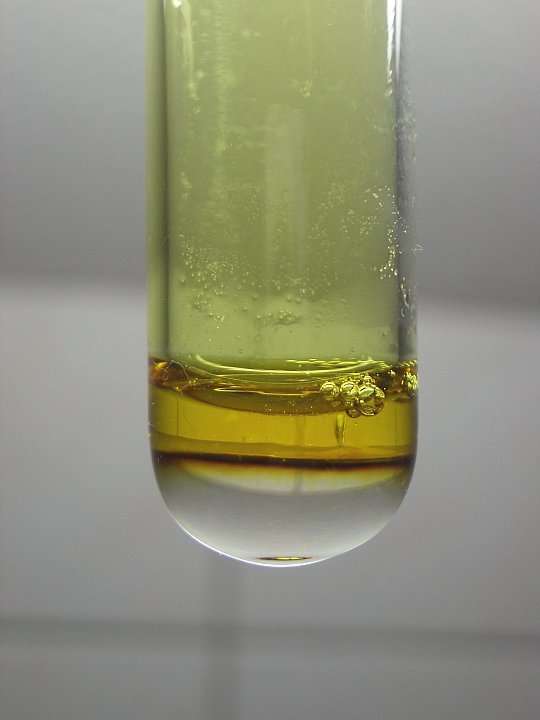
From the same test tube, a picture is made, but now looking at the dark layer from above. The hydrochloric acid is deep yellow, due to dissolved chlorine dioxide, then there is the brown layer and at the bottom there is the colorless solution of sodium chlorite in water.
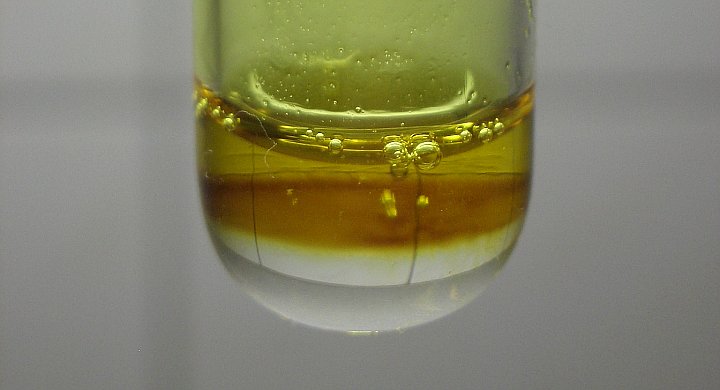
When the test tube is swirled, such that the liquids mix, then it starts foaming briefly and a lot of gas is produced. The solution becomes deep yellow/brown and long after the bubbling ceases, still quite some gas is given off from the solution.
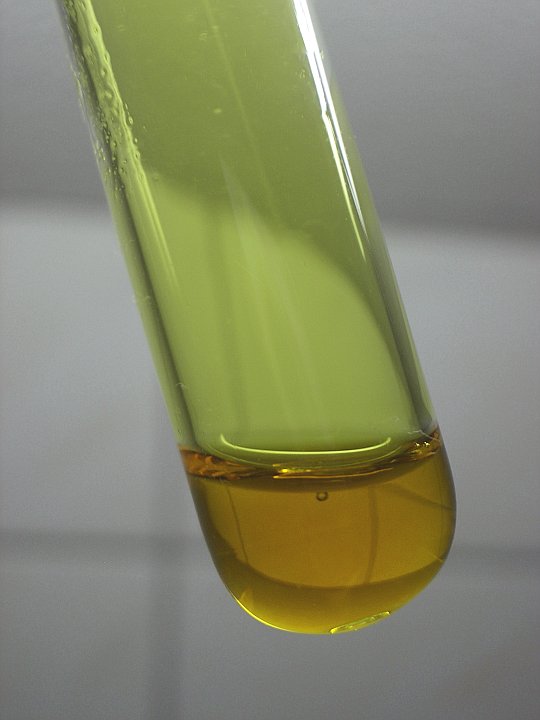
The final result of making chlorine dioxide is shown in the picture below. Most striking is the intense color of the gas. This is a standard test tube with 16 mm diameter, but even in this thin layer, the gas already has an intense color.
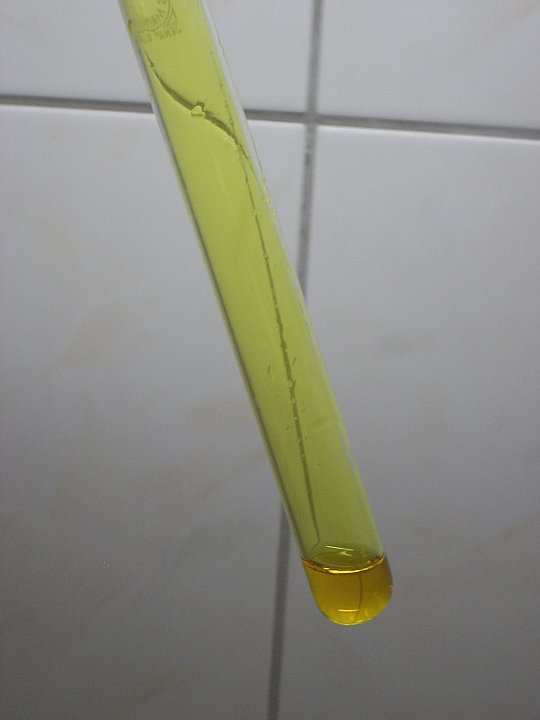
![]()
Igniting the gas in a test tube
When pure chlorine dioxide is ignited, then it explodes when the concentration is sufficiently high. When the concentration is lower and the gas is not confined, then it does not explode, but a 'decomposition front' moves through the gas and while it passes through the gas, the gas decomposes.
At sufficiently high concentration of the gas, one can also see a flame. This flame is very pale grey. Under normal light conditions, it only can be seen, when one is looking carefully. The three pictures below show a test tube, filled with nearly pure gas, just before decomposition, at the moment of decomposition, and immediately after. During decomposition, a flame can be observed. Decomposition is fast, the time between two images is 33 ms. The middle image shows the flame.


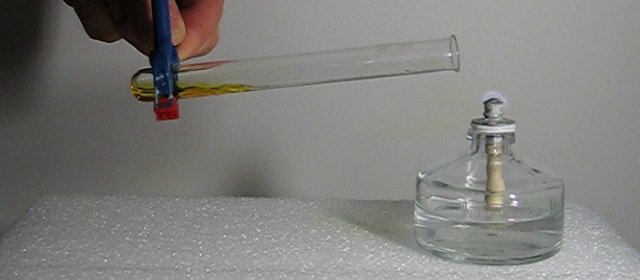
A similar experiment was done in a dimly lit room. Under such lighting conditions, the flame of the exploding gas can be observed more easily. The middle shows a clearly visible flame, but the end of the flame at the bottom of the test tube still can be observed in the last picture.
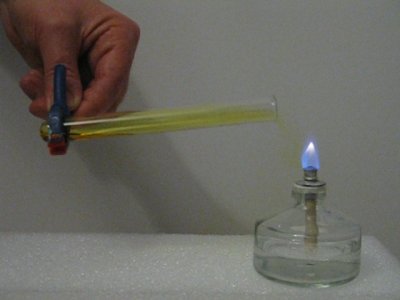
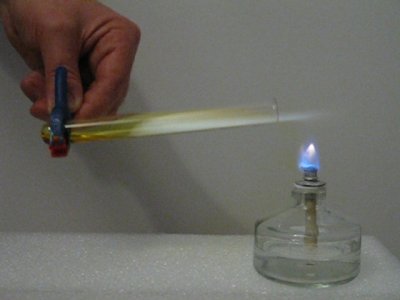
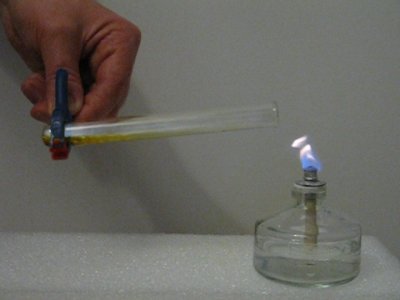
In these experiments, the sound of the explosion resembles the sound of an exploding hydrogen/air mix in a test tube. Watch and listen at the two videos, which demonstrate the explosion of the gas.
- explosion of gas under normal light condition (download size is 661 KByte)
- explosion of gas under dimly lit condition (download size is 1.2 MByte)
When a gas/air mix is ignited with a much lower concentration of chlorine dioxide, then there is no explosion, but a kind of whistling noise is produced. At concentration of appr. 20% by volume, the gas does not really make a noise anymore, and one can clearly see how the gas is decomposed. The whistling noise is demonstrated in the following video: whistling noise of decomposing chlorine dioxide. Download size is approximately 1.8 MByte.
![]()
Igniting the gas in a long transparent tube
A nice experiment is to fill a long glass tube with a mix of chlorine dioxide and air. In this experiment a tube is used with a 12 mm inner diameter, and a length of approximately 50 cm.
Filling of the long tube is done by keeping the tube in front of the open end of a test tube, immediately after some concentrated hydrochloric acid is added to some 30% solution of sodium chlorite. Any open space between test tube and long glass tube is covered with glass wool. This keeps most gas inside the tubes. Approximately 2 ml of both liquids is used.
When the long tube is halfway filled with gas, then both ends are stoppered with glass wool and the long tube is turned around a few times in order to mix the gas and the air inside the tube.
After the mixing, one end of the long tube is opened, and the gas is ignited. The experiment was performed two times. The first time, the concentration of the gas was fairly high, and the reaction proceeds so fast, that the entire length of the tube is decomposed almost at once. The second time, the concentration was sufficiently low to see the 'decomposition front' moving through the tube. Below follows a series of pictures, covering 0.3 seconds of time.








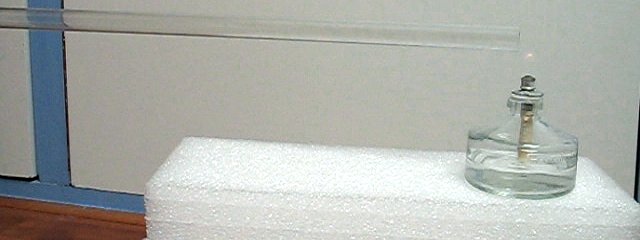
Two videos are available as well. These demonstrate the decomposition of the gas, and the noise made by the glass tube. A nice roaring noise is made, especially in the second experiment, where the decomposition front is moving slower.
- fast decomposition of chlorine dioxide (download size 415 KByte)
- slower decomposition of chlorine dioxide (download size 665 KByte)
![]()
Discussion of results
![]() Sodium chlorite reacts with acids and in this reaction,
chlorous acid, HClO2, is formed. Chlorous acid is unstable and
disproportionates as follows:
Sodium chlorite reacts with acids and in this reaction,
chlorous acid, HClO2, is formed. Chlorous acid is unstable and
disproportionates as follows:
5HClO2 → 4ClO2(g) + Cl– + H+ + 2H2O
It is remarkable how pure the gas is, which is produced in this way. No smell of chlorine can be observed, when the gas is made from acidified chlorite. Chlorine dioxide is not nearly as pungent as chlorine gas. It is a toxic gas, but it is not as choking as chlorine gas. This is because in aqueous solution, chlorine dioxide reacts rather sluggishly.
An alternative method of producing chlorine dioxide is the use of chlorate instead of chlorite, using hydrochloric acid as reductor. This could be done if no sodium chlorite is available, but the effect is sub-optimal.
5ClO3– + Cl– + 6H+ → 6ClO2(g) + 3H2O
This reaction, however, does not give pure chlorine dioxide. A side reaction occurs:
ClO3– + 5Cl– + 6H+ → 3Cl2(g) + 3H2O
A reasonable approximation of the net reaction which occurs in reality is:
2ClO3– + 2Cl– + 4H+ → Cl2(g) + 2ClO2(g) + 2H2O
The exact stoichiometry of the reaction, however, can deviate significantly from the last equation, but it always will be a linear combination of the other two.
![]() Chlorine
dioxide is an unstable radical. It is an highly endothermic compound, and it
easily decomposes, with the release of a lot of energy:
Chlorine
dioxide is an unstable radical. It is an highly endothermic compound, and it
easily decomposes, with the release of a lot of energy:
2ClO2 → Cl2 + 2O2